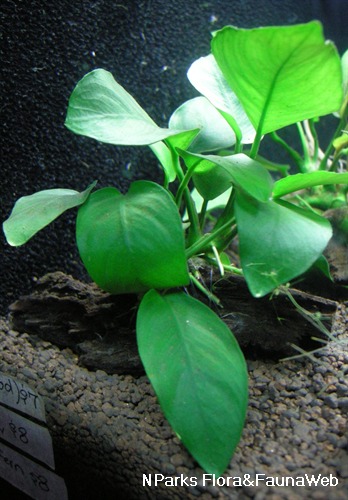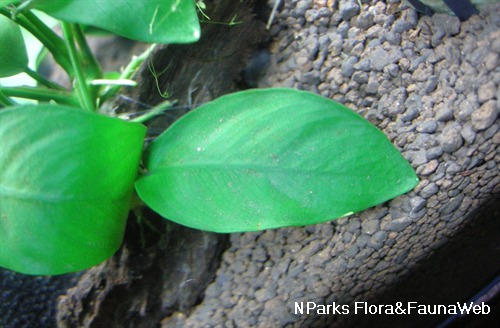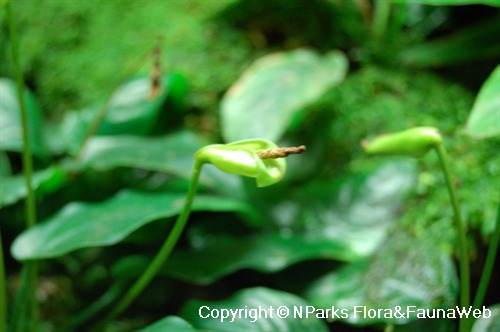
Name
Classifications and Characteristics
| Plant Division | Angiosperms (Flowering Seed Plants) (Monocotyledon) |
|---|---|
| Plant Growth Form | Herbaceous Plant, Aquatic & Hydrophyte (Waterside / Marginal) |
| Lifespan (in Singapore) | Perennial |
| Mode of Nutrition | Autotrophic |
Biogeography
| Native Distribution | West Africa |
|---|---|
| Native Habitat | Aquatic (Freshwater Pond / Lake / River), Terrestrial (Riverine) |
| Preferred Climate Zone | Tropical |
| Local Conservation Status | Non-native (Horticultural / Cultivated Only) |
Description and Ethnobotany
| Growth Form | It is a broad-leaved, herbaceous perennial. It grows in emersed conditions though it can also be grown submerged underwater. |
|---|---|
| Foliage | The thick and leathery leaves are dark green and oblong with an acute apex, an entire margin and net venation. The leaf petiole can grow up to 5cm long with leaf width up to 2.8cm wide. The leaves are also unplatable to herbivorous fishes hence, making it an ideal plant for aquascaping. |
| Stems | It produces a creeping rhizome on which adventitious roots form. |
| Habitat | It can be found in marshes, streams and riverbanks under shady cover of the forest. |
| Taxonomy | This variety is the smallest known form among the genus Anubias. |
| Cultivation | It is ideally grown under partial shade in water temperatures of 22 to 26°C and in water with pH levels of 5.5 to 8.0. A slow-growing but hardy plant, it can also be grown emersed in water and grows best under hot and humid conditions. A suitable plant for beginners, it has no need for additional fertilisation. |
| Etymology | The genus name is derived from the name of the Eygptian God Anubis. |
Landscaping Features
| Desirable Plant Features | Ornamental Foliage, Ornamental Form |
|---|---|
| Landscape Uses | Aquarium / Aquascape |
Plant Care and Propagation
| Light Preference | Semi-Shade |
|---|---|
| Water Preference | Lots of Water |
| Rootzone Tolerance | Easy to Grow |
| Planting Remarks | To prevent the plant. from floating, attach the rhizome to pieces of rocks or driftwood using fishing line or black thread. Do not bury the rhizome or else it will rot. |
| Maintenance Requirements | Low |
| Propagation Method | Division |
| Plant Growth Rate Remarks | This plant has a slow growth rate. |
| Propagation Method Remarks | It is propagated from the eyes of the rhizome. |
Foliar
| Foliage Retention | Evergreen |
|---|---|
| Mature Foliage Colour(s) | Green |
| Mature Foliage Texture(s) | Smooth |
| Foliar Type | Simple / Unifoliate |
| Foliar Attachment to Stem | Petiolate |
| Foliar Shape(s) | Non-Palm Foliage (Oblong) |
| Foliar Venation | Pinnate / Net |
| Foliar Margin | Entire |
| Foliar Apex - Tip | Acute |
Floral (Angiosperm)
| Flower Grouping | Cluster / Inflorescence |
|---|---|
| Inflorescence Type | Spathe & Spadix |
Image Repository
Others
| Master ID | 31360 |
|---|---|
| Species ID | 5757 |
| Flora Disclaimer | The information in this website has been compiled from reliable sources, such as reference works on medicinal plants. It is not a substitute for medical advice or treatment and NParks does not purport to provide any medical advice. Readers should always consult his/her physician before using or consuming a plant for medicinal purposes. |


